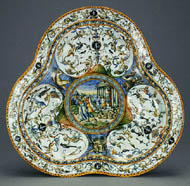1. Distribute clay and tools. Have students begin constructing their vessel, working from the design they developed for homework.
2. As students work independently on their clay forms, circulate among them, asking them individually about their artistic choices.
Inquire about the following:
• construction techniques
• surface qualities
• interior and exterior
• function or non-function
• symbolic attributes
• expressive qualities
3. Once students have built a portion of their vessel, ask them to identify and discuss as a class elements of their design
that were derived from the historical ceramic artwork examples viewed in class, and others that they may have studied.
Discuss the difference between copying and creative appropriation of ideas from the works of other artists. You might use
the following questions:
• What reasons might an artist have to imitate the work of another artist?
• Is a work of art original if the artist has borrowed elements from another work?
• Is it possible to create an entirely original work of art?
4. Direct students through the processes of finishing, glazing, and firing their ceramic objects.
|
 |
 |
 |
| Basin with Deucalion and Pyrrha, Orazio Fontana or his workshop, 1565–1571 |
 |
|
 |
Common Core Standards for English Language Arts
Grades 9–12
SPEAKING AND LISTENING
Comprehension and Collaboration
1. Prepare for and participate effectively in a range of conversations and collaborations with diverse partners, building on others' ideas and expressing their own clearly and persuasively.
2. Integrate and evaluate information presented in diverse media and formats, including visually, quantitatively, and orally.
3. Evaluate a speaker's point of view, reasoning, and use of evidence and rhetoric.
Presentation of Knowledge and Ideas
4. Present information, findings, and supporting evidence such that listeners can follow the line of reasoning and the organization, development, and style are appropriate to task, purpose, and audience.
Visual Arts Content Standards For California Public Schools
Grades 9–12 Proficient
2.0 Creative Expression
Creating, Performing, and Participating in the Visual Arts
2.1 Solve a visual arts problem that involves the effective use of the elements of art and the principles of design.
2.2 Prepare a portfolio of original two-and three-dimensional works of art that reflects refined craftsmanship and technical skills.
4.0 Aesthetic Valuing
Responding to, Analyzing, and Making Judgments About Works in the Visual Arts
4.1 Articulate how personal beliefs, cultural traditions, and current social, economic, and political contexts influence
the interpretation of the meaning or message in a work of art.
4.4 Articulate the process and rationale for refining and reworking one of their own works of art.
4.5 Employ the conventions of art criticism in writing and speaking about works of art.
National Standards for Visual Arts Education
Grades 9–12
1. Understanding and applying media, techniques, and processes
a. Apply media, techniques, and processes with sufficient skill, confidence, and sensitivity that their intentions are carried out in their artworks.
b. Conceive and create works of visual art that demonstrate an understanding of how the communication of their ideas
relates to the media, techniques, and processes they use.
2. Using knowledge of structures and functions
c. Create artworks that use organizational principles and functions to solve specific visual arts problems.
3.Choosing and evaluating a range of subject matter, symbols, and ideas
b. Apply subjects, symbols, and ideas in their artworks and use the skills gained to solve problems in daily life.
c. Describe the origins of specific images and ideas and explain why they are of value in their artwork and in the work of others.
d. Evaluate and defend the validity of sources for content and the manner in which subject matter, symbols, and images are
used in the students' works and in significant works by others.
|
 |

|
 |